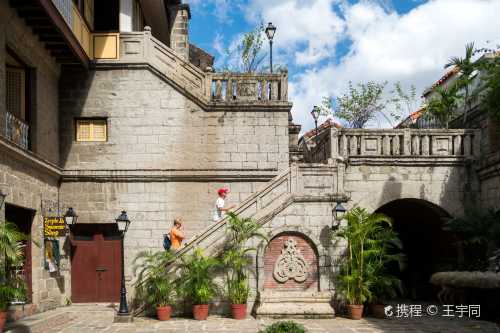Casa Manila is a Spanish-style house museum located in Intramuros, Manila, Philippines. It was built in 1981 by the order of Imelda Marcos, the former first lady of the country, to recreate the living conditions of the upper class Filipinos during the Spanish colonial era, especially in the late 19th century. The building of Casa Manila was designed by Filipino architect José Ma. Zaragoza, who was inspired by the “House of Don Severino Mendoza” in Biñan, Laguna. The building is a “bahay na bato”, a half-timbered, half-stone house, a traditional Philippine architecture influenced by Spain. It is characterized by the lower floor made of cement or stone and the upper floor made of wood, with wooden louver windows and shell glass (capiz windows). The museum is decorated with antique furniture from the colonial era, such as carved wooden beds, cabinets, tables, tableware, silverware, paintings and home decorations that reflect the luxury and lifestyle of the “Ilustrado” or upper-middle class Filipinos at that time. They often had connections to the Spanish government or were wealthy from trade. Casa Manila is located in the Plaza San Luis Complex, a collection of restored and rebuilt historic buildings to promote the preservation of traditional culture and tourism. Casa Manila is one of the major examples of the Intramuros Revival Project, carried out by the Intramuros Administration. A visit to Casa Manila offers a journey back in time to the colonial era. Visitors will learn about the lifestyle, family relationships, the role of domestic servants, and the traditional banquets of the Filipino upper class. Although it is a reconstruction of a later building, Casa Manila is valuable for preserving the culture, architecture, and understanding of Philippine history, especially the period when Spain had a great influence on the country’s politics, religion, language, and social structure. Today, Casa Manila is a major tourist attraction in Manila, visited by both local and international tourists. It has also been the setting for many period TV shows, documentaries, and dramas. It is an important destination for those who want to gain a deeper understanding of the cultural roots of the Filipino people during the colonial era.
người Thái
Popular Trip Moments
Manila's Walled City: A Time Capsule of Intramuros | Routine & Ritual, Manila’s Everyday Brew Haven | Verses & Vibes, Manila’s Soulful Sip Sanctuary | Focus & Flavor, Manila’s Sharp-Sipping Hideout | Sun & Stillness, Manila’s Gentle Japanese Escape | Crumbs & Canvas, Manila’s Artful Bake Retreat | good cafe | Whispers & Wonder, Manila’s Dreamspace | Stories in Steam, Manila’s Brewed Chapters | First Light, Manila’s Quiet Beginning | Timeless Grounds, Manila’s Vintage Pulse | Brews & Personas, Manila’s Playful Shift | Lost & Brewed, Manila’s Glitch in the Grind | Seoulful Sips, Manila’s Taste of Tradition | Featherlight Moments, Manila’s Gentle Nest | Curiously Cozy, Manila’s Quirky Hideout | From city lights to mountain mists ✨ — Manila Guide | good food | nice food and coffee | good food and coffee | Whimsy Hops, Cozy Stops | Whisked Warmth, Manila’s Cozy Corner | A Peak Into Casa Manila | Echoes of History | Exploring Manila Ocean Park: A Marine Adventure Guide | great coffee | MANILA OCEAN PARK & BIODOME BLISS | Barbara’s Heritage Restaurant: A Cultural Feast of Music, Dance, and Cuisine
Recommended Attractions at Popular Destinations
Popular Attractions in Sydney | Popular Attractions in Dubai | Popular Attractions in Paris | Popular Attractions in Shanghai | Popular Attractions in Phuket | Popular Attractions in New York | Popular Attractions in Tokyo | Popular Attractions in Bali | Popular Attractions in Melbourne | Popular Attractions in West Lake | Popular Attractions in Iguazu National Park(Argentina) | Popular Attractions in London | Popular Attractions in Rome | Popular Attractions in Kuala Lumpur | Popular Attractions in Chefchaouene | Popular Attractions in Singapore | Popular Attractions in Kyoto | Popular Attractions in Los Angeles | Popular Attractions in Zanzibar Island | Popular Attractions in Las Vegas | Popular Attractions in Osaka | Popular Attractions in Walt Disney World Resort | Popular Attractions in Beijing | Popular Attractions in Bangkok | Popular Attractions in Barcelona | Popular Attractions in Chengdu | Popular Attractions in Florence | Popular Attractions in Madrid | Popular Attractions in Jungfrau Region | Popular Attractions in Istanbul
Popular Attractions
Shanghai Wild Animal Park | Tai Hu Yuantouzhu Scenic Spot | Guilin Park | Oriental Pearl Radio & Television Tower | Lion Grove Garden(Shizilin Garden) | North Bridge | Dalian Laohutan Ocean Park | Bingyu Valley | Dalian Haiwang Nine Islands Tourist Area | Slender West Lake | Daming Temple | Labor Park | He Garden | Gumulan Yard Shita | Xinghai Park | Zheng Chenggong Training Field Ruins | Hulishan Fortress | The Jimei School Village | Five Figures' Temple | Jardim da Montanha Russa | Ak"Yar Dzhami | Downton Library | Iglesia de Cuatro Bocas | Gerhardt Braun Gallery | Parroquia del Santisimo Sacramento | Jamia Masjid Farooqiya | Cascada El Subi | Parrocchia di Pellegrina | Jaigaon Presbyterian Church | Shaler Crest Park
Popular Restaurants in Manila
Dads world buffet | Wai Ying Fast Food | Salazar Bakery | Shawarma Snack Center | Harbor View Restaurant | Ilustrado Restaurant | Tanabe Japanese Restaurant | The Aristocrat Restaurant | The Original Salido Restaurant | Cafe Adriatico | Dong Bei Dumplings | Ristorante Delle Mitre | 9 SPOONS - The Bayleaf Intramuros | Patio de Conchita Restaurant | Sky Deck View Bar | Uno Seafood Wharf Palace | Mang Inasal | Barbara's Heritage Restaurant | Raffaele Woodfired Pizza, The Bayleaf Hotel | New Toho Food Center | Bistro Remedios | Yurakuen Japanese Restaurant | Mei Sum Tea House | Jollibee | Sincerity - Lucky Chinatown | Kenny Rogers Roasters | Purple Yam Malate Kitchen - Korea Town Manila | President Grand Palace | Gerry's Robinsons Place Ermita (Gerry's Grill) | Emerald Garden
Popular Ranked Lists
Top 50 Trending Attractions in Shanghai | Popular Premium Hotels in Whitianga | Top 10 Trending Attractions in Harbin | Popular Premium Hotels in Boothbay Harbor | Top 20 Trending Attractions in Chongqing | Top 50 Must-Visit Restaurants in Singapore | Popular Trending Attractions in Edinburgh | Top 50 Must-Visit Restaurants in Osaka | Top 50 Must-Visit Restaurants in Tokyo | Top 50 Luxury Hotels near Innsbruck | Top 50 Must-Visit Restaurants in Santorini | Popular Premium Hotels in Yangyang | Top 10 Trending Attractions in Zibo | Popular Trending Attractions in Rizhao | Top 10 Trending Attractions in New York | Popular Trending Attractions in Hexigten Banner | Popular Premium Hotels in Sagres | Popular Premium Hotels in Rantum | Top 50 Must-Visit Restaurants in Kuala Lumpur | Top 20 Must-Visit Restaurants in Tonglu | Popular Premium Hotels in Chattanooga | Top 10 Trending Attractions in Seoul | Popular Premium Hotels in Cher | Popular Premium Hotels in Adare | Popular Trending Attractions in Hefei | Top 20 Must-Visit Restaurants in Tongxiang | Popular Trending Attractions in Hong Kong | Top 50 Must-Visit Restaurants in Shanghai | Popular Trending Attractions in Wuyuan | Top 50 Must-Visit Restaurants in Paris
About
Payment methods
Our partners
Copyright © 2025 Trip.com Travel Singapore Pte. Ltd. All rights reserved
Site Operator: Trip.com Travel Singapore Pte. Ltd.
Site Operator: Trip.com Travel Singapore Pte. Ltd.
















